
Sustainability in Hong Kong
Hong Kong is a diverse city, home to many beautiful cultures far and wide. It is an international stopping point for many freight ships and an iconic city in the fashion world. As it continues to further as a hotspot for many anthropocentric activities, its current state trends are threatened with many challenges that harm the sustainable development of this iconic city. Of these challenges, I have highlighted three sustainability challenges and two sustainable activities that I experienced while abroad on my global intensive experience.
Sustainable: wet markets
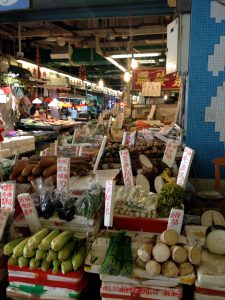
Within my experience in Hong Kong, the wet markets within the city were one of the most memorable experiences for me. They were a collective hotspot for local vendors to sell fresh vegetables, meat and produce. Though it was not clear whether all or most of the fruits/veggies were local, these intergenerational shops represent a future and vision of sustainability. These wet markets are multi-story centers for people all over the city to come and make relationships with the vendors that sell them their foods. Not only does it cut back on consumer carbon footprints by providing many wet markets locally, but also fresh produce adds to a good nutritional component within the consumer scale. These wet markets are also sustainable because it becomes a part of the future generation’s livelihood by ensuring space and place for fresh produce (with reduced packaging), community ties/bonding, keeping money locally, and a generational passing on of shops within a family. When I visit farmers markets here, I wish I saw those social and community values/ties as Hong Kong clearly has. I see they are developing, but yet have far to come to reach the intensity that HK functions under.
Sustainable: Eco Park
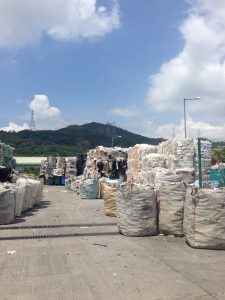
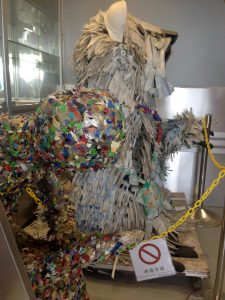
Eco Park in Tuen Mun is a perfect example of a sustainability outcome. Placed all over Hong Kong are recycling bins that are sorted into 3 or 4 baskets for different recycling wastes. Most of which ends up at the Eco Park, a recycling and e-waste plant. Of the e-waste sent here, Eco park works to repurpose, fix and donate, or break down the products. All other papers, plastics and recyclables are sent through sorters that then clean and grind down scraps to be recycled for the making of other materials. Eco Park hosts educational activities that inform the public on recycling and ways to repurpose or reduce your waste. This is an amazing sustainability outcome because it shows there is opportunity and ways to overcome trash and recycling problems. Being back in Arizona and looking back on this field trip, I am shocked at how well they process their recyclables. Our recycling bins are not as nearly well sorted as Hong Kong’s, nor is recycling a ‘mainstream activity’ here in Arizona. It seemed that in Hong Kong, a lot of the general public cares about recycling, like it was a value to them. Here, we are still fighting to convince the general public that recycling is better for the environment. I am impressed with Hong Kong’s ability to manage so much recyclable and e-wastes and I hope that the US soon follows suit in better ways to manage and take care of recyclables.
Sustainability challenge: land use challenges
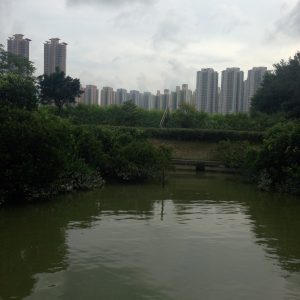
The land use challenges Hong Kong faces was the absolute most memorable to me. This is probably because it was my group’s topic for the assignment on my study abroad experience. I chose to use this issue as an example of a sustainability challenge because it really resonates with me. As my group did research on this, and looked at cultural ties, intergenerational communities/shops, and the loss of cultural heritage with redevelopment projects, I really felt for the people of Hong Kong. This picture demonstrates only a taste of the land use challenges by showing how there is a fight for space, between housing/shops and other uses like a wetland park. The buildings in this picture are also all housing on the new territories that were actually a part of a reclamation project. So many people are migrating into Hong Kong, which provides so little space that housing has to be so dense to best utilize the land. Land use challenges impact every pillar of sustainability: the economic, environment and social aspects as it takes a toll on family/community values, ties, expenses, as well as the environment. Phoenix is the opposite of Hong Kong, built out not up. It is one of the largest cities in the US because it has such an urban sprawl. Due to looking at land use challenges in HK, it has me questioning, even more now, how we are considering conservation and land use/planning. Our transportation system is the worst, it can take hours to get from one side of Phoenix to the other, and it seems as though we are consistently with vacant lots within the city. I think Phoenix needs to re-evaluate its urban sprawl and focus more on developing the inner city, for multi-use development. Currently, private developers are tearing down Roosevelt Point (downtown Phoenix) piece by piece. This is almost similar to what Hong Kong faces with URA projects. Private developers are ripping out the arts district, full of Phoenix culture and murals, for modern housing.
Un-sustainable: Hong Kong nightly light show
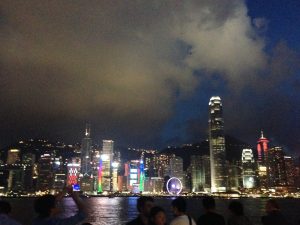
The infamous nightly light show in Hong Kong is a sustainability challenge that could easily be overcome. It is an energy issue. The light show uses so much energy and it is not necessary to do a 45-minute lightshow every single night of the year. If this show would be reduced to once or twice per week, Hong Kong could save so much money and resources that could otherwise be put towards other areas. Reducing the amount of times it occurs would also peak attendance and tourism to the city areas. I chose to highlight this experience because it is a tourist attraction, but also an energy crisis or challenge that could otherwise easily be avoided by reducing the number of times it happens. Seeing this light show and addressing its energy usage has inspired me to watch my energy consumption much more closely.
Sustainability challenge, local trade-off: seafood vs. livestock
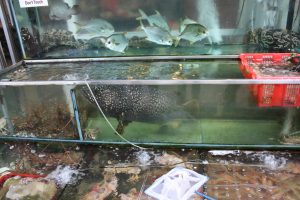
Fisheries in general, all across the globe, are becoming more unsustainable as we see fish stocks being depleted and shipped across the globe. In Hong Kong, seafood consumption is much higher than other parts of the world. There is also very little Hong Kong land available for livestock rearing. This represents almost a global trade-off; US and other countries focus on the consumption of livestock like beef, pork and chicken, while other countries tend to consume more seafood. Livestock faces certain challenges that seafood wouldn’t and vice versa. As the challenges associated with livestock rearing and fisheries become more widespread, innovative and productive solutions will need to be implemented to combat its unintended consequences. In HK, it makes sense due to land use challenges, that livestock consumption would be less abundant. In Phoenix, a landlocked state, not a lot of seafood is consumed and most meat comes from livestock. So here, we face sustainability challenges with the carbon output, pollution, water, and other terrestrial, ecological challenges associated with the choice to raise and consume meat.

